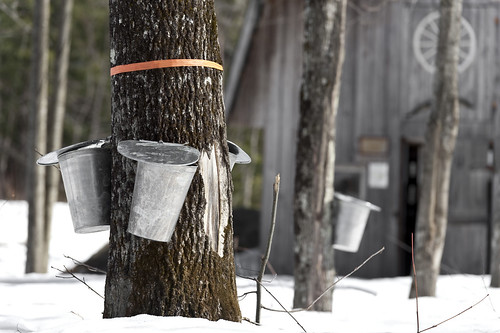
Maple syrup collection in a sugar bush. NIFA grants support camps that allow tribal youth to experience cultural tradition while learning about plant science. (iStock image)
Many children look forward to gathering pumpkins in the fall. For some Native American children, another well-loved tradition is gathering maple syrup in early spring. USDA’s National Institute of Food and Nutrition (NIFA) provides grants to support a unique camp where reservation youth can experience their cultural traditions while learning plant science.
Maple syrup is one of the oldest agricultural products in the United States and is one of the foods the first Americans shared with European settlers. Dr. Steven Dahlberg, director of Extension at White Earth Tribal and Community College (WETCC), used part of a $100,000 NIFA’s Tribal College Extension Grant to support four seasonal camps for at-risk youth, including one where they learn to keep their traditions alive at sugar bush camps. A “sugar bush” is a grove of maple trees used to produce syrup. Participants also discover how to transform watery maple sap into the syrup we know and love. In Minnesota, the Fond du Lac, Leech Lake, and White Earth tribes hold sugar bush camps in spring when most trees are full of sap. No fancy machinery is required here; campers use the traditional method of cooking sap over a wood fire, where it often takes days to process the syrup.
Camp instructors teach the youth about the science of xylem and phloem (the systems of transporting water, minerals, food, etc., throughout a plant) and why the trees produce the sugar sap. Tribal elders explain the cultural and historic significance of maples to the campers. It’s all part of a bigger initiative to promote food security in an area where grocery stores are scarce. A home garden can simultaneously improve a family’s food security and health. Extension efforts by tribal land-grant universities work mainly with parents to help families avoid hunger through home gardening and food preservation. Local food production can also mean extra income in a community where unemployment can run as high as 25 percent.
“In the last 12 years I’ve seen a significant growth in the number of people who participate in sugar bush camps—even setting up their own operations—often for the first time,” said Dr. Dahlberg. “It is very satisfying for me to see the renewal of these important cultural traditions. Our funding from the various NIFA Tribal College Grant Programs has been critical to our ability to offer this program.”
These interactive workshops not only educate, they also give us a glimpse into the history of American Indians and how they used their natural habitat to cultivate such a rich culture. “I’m proud that we have had a major focus on teaching students and community members about this and many other important traditional skills for the Anishinaabeg people,” Dahlberg said.
NIFA’s mission: Invest in and advance agricultural research, education, and Extension to solve societal challenges. NIFA’s vision: Catalyze transformative discoveries, education, and engagement to address agricultural challenges. For more information, visit http://nifa.usda.gov/.
No comments:
Post a Comment
Note: Only a member of this blog may post a comment.